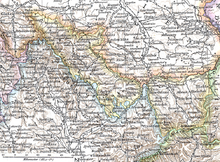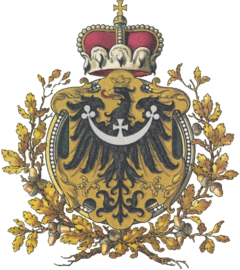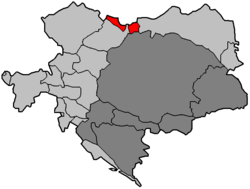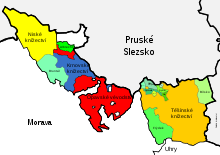- Austrian Silesia
-
- See also Duchy of Silesia.
Duchy of Upper and Lower Silesia
Herzogtum Ober- und NiederschlesienKronland of the Kingdom of Bohemia and the Austrian Empire, from 1867 Cisleithanian Kronland of Austria–Hungary ← 
←
←
1742–1918  →
→
 →
→

Flag Coat of arms Austrian Silesia (shown in red) within Austria-Hungary until 1918 Capital Opava Language(s) German, Polish, Czech Government Principality History - Division of Silesia 1742 - Part of Austrian Empire 1804 - Crown land of
Cisleithania1867 - Disestablished 1918 Area - 1910 5,147 km2 (1,987 sq mi) Population - 1910 est. 756,949 Density 147.1 /km2 (380.9 /sq mi) Today part of  Czech Republic
Czech Republic
 Poland
PolandAustrian Silesia (German: Österreichisch Schlesien; Czech: Rakouské Slezsko; Polish: Śląsk Austriacki), officially the Duchy of Upper and Lower Silesia (German: Herzogtum Ober- und Niederschlesien) was an autonomous region of the Kingdom of Bohemia and the Austrian Empire, from 1867 a Cisleithanian crown land of Austria-Hungary. It is largely coterminous with the present-day region of Czech Silesia, and was, historically, part of the larger Silesia region.
Contents
Geography
 Austrian Silesia (outlined in yellow), Richard Andree, 1880
Austrian Silesia (outlined in yellow), Richard Andree, 1880
Austrian Silesia consisted of two territories, separated by the Moravian land strip of Moravské Ostrava between the Ostravice and Oder rivers.
The area east of the Ostravice around Cieszyn reached from the heights of the Western Carpathians (Silesian Beskids) in the south, where it bordered with the Kingdom of Hungary, along the Olza and upper Vistula rivers to the border with Prussian Silesia in the north. In the east the Biała river at Bielsko separated it from the Lesser Polish lands of the Polish–Lithuanian Commonwealth, incorporated into the Austrian Kingdom of Galicia and Lodomeria upon the First Partition of Poland in 1772.
The territory west of the Oder river stretching from the town of Opava up to Bílá Voda was confined by the Jeseník mountain range of the eastern Sudetes in the south, separating it from Moravia, and the Opava river in the north. In the west the Golden Mountains formed the border with the County of Kladsko.
History
The area originally formed the southeastern part of the medieval Duchy of Silesia, a province of the Piast Kingdom of Poland. During the 14th century most Dukes of Silesia had declared themselves Bohemian vassals.
As part of the Lands of the Bohemian Crown, Silesia was inherited by the Habsburg archduke Ferdinand I of Austria in 1526, after the the last Jagiellon king Louis II of Bohemia had died at the Battle of Mohács. With the female succession of the Habsburg empress Maria Theresa to the throne in 1740, the Prussian king Frederick the Great laid claim to the Silesian province and, without waiting for any reply, on 16 December started the First Silesian War, thereby opening the larger War of the Austrian Succession. His campaign was concluded in 1742 with the Prussian victory at the Battle of Chotusitz leading to the treaties of Breslau and Berlin, in which Silesia was divided.
Under the terms of the treaty, the Kingdom of Prussia received most of the territory including the Bohemian County of Kladsko, while only a small part of southeastern Silesia remained with the Habsburg Monarchy, consisting of:
- the Upper Silesian duchy of Teschen (Cieszyn)
- parts of the former Moravian Duchy of Opava with Duchy of Krnov south of the Opava River, comprising several Moravian enclaves.
- the southern part of the Lower Silesian Duchy of Nysa around Jeseník
forming the Duchy of Upper and Lower Silesia, which remained a Bohemian crown land with its capital in the city of Opava. In 1766 the title of a Duke of Teschen was granted to Prince Albert of Saxony, son-in-law of Maria Theresa, while the title of a Duke of Troppau and Jägerndorf remained with the Princely Family of Liechtenstein. The Nysa territory was held by the Bishops of Wrocław with their residence at Castle Jánský vrch (Johannisberg).
When in 1804 the Habsurg emperor Francis II established the Austrian Empire, his title would include the "Duke of Upper and Lower Silesia". Austrian Silesia was connected by rail with the Austrian capital Vienna, when the Emperor Ferdinand Northern Railway line was extended to Bohumín station in 1847. In the course of the Austro-Hungarian Compromise of 1867 the Duchy of Upper and Lower Silesia became a crown land of Cisleithanian Austria.
In 1918, the Austrian monarchy was abolished and the major part of Austrian Silesia was ceded to the newly-created state of Czechoslovakia by the 1919 Treaty of Saint-Germain-en-Laye, with the exception of Cieszyn Silesia (the former Duchy of Teschen), which after the Polish–Czechoslovak War was split in 1920 along the Olza river with its eastern part falling to the Autonomous Silesian Voivodeship of Poland. Smaller parts of the duchy also became a part of Poland, while the adjacent Hlučín Region of Prussian Silesia fell to Czechoslovakia.
 Coat of arms of the Duchy of Upper and Lower Silesia, Hugo Gerhard Ströhl (1851–1919)
Coat of arms of the Duchy of Upper and Lower Silesia, Hugo Gerhard Ströhl (1851–1919)
Demographics
According to an Austrian census, Austrian Silesia in 1910 was home to 756,949 people, speaking the following languages:
- 43 % - German
- 31 % - Polish
- 26 % - Czech
Major towns
Towns with more than 5,000 people in 1880:
Cities German name Population Opava Troppau 20,563 Bielsko Bielitz 13,060 Cieszyn/Těšín Teschen 13,004 Krnov Jägerndorf 11,792 Bruntál Freudenthal 7,595 Frýdek Frydek 7,374 (1890) Administration
The Duchy of Upper and Lower Silesia was originally divided into the two districts (Bezirke) of Teschen (Těšínský kraj, pop. 213,040 in 1847) and Troppau (Opavský kraj, pop. 260,199) with its seat at Krnov. In eastern Teschen, the autonomus Duchy of Bielsko was established in 1754. Upon the Revolutions of 1848, Austrian Silesia was re-organised into the districts of:
- Teschen (Těšín)
- Freistadt (Fryštát)
- Freiwaldau (Frývaldov)
- Freudenthal (Bruntál)
- Frydek
- Hultschin (Hlučín)
- Jägerndorf (Krnov)
- Troppau (Opava)
- Wagstadt (Bilovec).
External links
Silesia topics History Symbols Coats of arms · Flags · Unofficial Anthems: Schlesien Unvergessene Heimat · Schlesierlied · Slezská hymnaEconomy Tourism · Upper Silesian Coal Basin (with: Upper Silesian Industrial Region · Rybnik Coal Area · Ostrava-Karviná Coal Area) · Lower Silesian Coal Basin · Legnicko-Głogowski Okręg Miedziowy · Bielski Okręg Przemysłowy · Silesian metropolitan area · Katowice urban areaCuisine Silesian dumplings · Black noodles · Makówki · Siemieniotka · Żur śląski · Wodzionka · Szałot · Kreple · Kołocz · Galert · Krupniok · Karminadle · Bryja · Moczka · Modra kapusta · Ciapkapusta · HauskyjzaLanguages Silesian (Cieszyn Silesian dialect · Lach Silesian dialect · Niemodlin Silesian dialect · Bytom Silesian dialect · Jabłonków Silesian dialect · Namysłów Silesian dialect · Prudnik Silesian dialect · Opole Silesian dialect · Syców Silesian dialect · Lower Silesian dialect · Sulkovian Silesian dialect · Texas Silesian) · German · Polish · Czech · Lower SilesianAdministrative
divisionsFormerDuchies (Piasts · Dukes) · Silesian Voivodeship (1920–1939) (Parliament · Treasury · Politicians) · State country · Province of Silesia / Upper Silesia / Lower Silesia · Sudetenland · New Silesia · Austrian Silesia · Eastern SilesiaPresentSilesian · Opole · Lower Silesian · Lubusz Voivodeships · Silesian-Moravian Region · Jeseník District · part of Saxony and Brandenburg (mainly in Niederschlesischer Oberlausitzkreis/Görlitz (district))Geography MountainsRiversLakesHighlands
Lowlands
OtherSilesian Highlands · Silesian Lowlands · Silesian-Lusatian Lowlands · Silesian Foothills · Silesian-Moravian Foothills · Oświęcim Valley · Ostrava Valley · Jelenia Góra valley · Kłodzko Valley · Zielona Góra Acclivity · Wał Trzebnicki · Przedgórze Sudeckie · Obniżenie Milicko-Głogowskie · Silesia Walls · Lower Silesian Wilderness · Silesian PrzesiekaOther Silesians · Silesian regional costumes (Śląskie stroje ludowe) · Silesian Autonomy Movement · Landsmannschaft Schlesien · Silesian architecture · Silesia national football team · Silesian Stadium · Silesian Football Association · Silesian-Moravian Football League · Silesian (European Parliament constituency) · Lower Silesian and Opole (European Parliament constituency) · Evangelical Church of Berlin-Brandenburg-Silesian Upper Lusatia · Silesian Evangelical Church of Augsburg Confession · FamilokWikiProject Silesia · Portal Duchies of Silesia 
Original 
Lower Silesia Upper Silesia Other Duchy of Upper and Lower Silesia · County of KladskoProvinces of the Austrian Empire Kingdom of Bohemia · Kingdom of Hungary · Kingdom of Illyria · Kingdom of Dalmatia · Kingdom of Croatia-Slavonia · Kingdom of Galicia and Lodomeria · Kingdom of Lombardy and Venetia · Archduchy of Austria · Duchy of Carinthia · Duchy of Carniola · Duchy of Salzburg · Duchy of Upper and Lower Silesia · Duchy of Styria · Duchy of Bukovina · Voivodeship of Serbia and Banat of Temeschwar · Grand Principality of Transylvania · Margraviate of Moravia · Princely County of Tyrol with Vorarlberg · Austrian Littoral (Princely County of Gorizia and Gradisca · Margravate of Istria · Imperial Free City of Trieste) · Military Frontier
 Categories:
Categories:- Former principalities
- Former countries in Europe
- Former vassal states
- States and territories established in 1742
- States and territories disestablished in 1918
- 1918 disestablishments
- History of Silesia
- History of Austria
- Former Slavic countries
Wikimedia Foundation. 2010.


